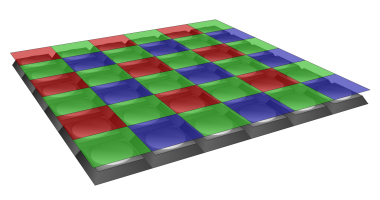
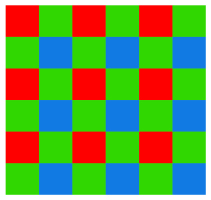
double number of green plates
The chip structure of a "1-chip" camera chip must be organized in a special way to capture colors.
There are different technologies in use as Bayer filters, CYGM filters and complementary filters. The Bayer filter is the standard technology for professional video.
Bayer filter: To capture all three RGB colors a special color filter layer is positioned on top of the pixel layer. Each pixel is covered with a small filter plate. The filter plates are colored red, green, blue, whereas the green plates are outnumbering the red and blue plates by the factor two to coincide with the high sensitivity of the human eye to the green color.
 |
 |
| Bayer Filter with filter layer over the pixel layer | filter arrangement with double number of green plates |
Each pixel delivers a signal that corresponds to the light intensity received through the filter layer. Because the pixels are covered with the three different types of filter plates, pixels deliver signals corresponding to the color intensity at the pixels location and each pixel is only receiving light in one of the three colors.
To get a complete color image out of this pixel and filter structure the individual signals of the individual pixels must be processed in a certain way. It is called 'Bayer-Demosaicing' or 'Bayer-to-RGB-conversion'. The intensity signals of neighboring pixels are combined and interpolated.
Green: four green values are combined to get the green value for the pixel in the middle of four green pixels.
Red: two red values are combined to get the red value of the pixel between two red pixels.
Blue: two blue values are combined to get the blue value of the pixel between two blue pixels.
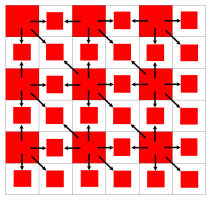 |
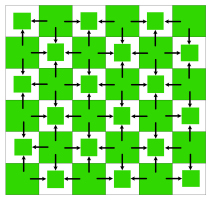 |
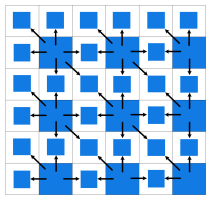 |
| combining for red pixels | combining for green pixels | combining for blue pixels |
Because each pixel receives parts of white light the black/white resolution is complete for the entire pixel number. But each color is combined of only a quarter (red and blue) or half (green) of all pixels and the true color resolution is compromised.
The resulting maximum format is 4:2:2.
The Bayer-to-RGB conversion can be executed in the camera itself or later in the signal chain at the host PC or frame grabber. Here the camera outputs raw data (normally 16 linear bits per pixel). After the conversion the entire signal bandwidth is three times higher than at the raw pixel level. The transmission of raw Bayer data gives a more flexible signal handling concerning the conversion algorithm and concerning the conversion point in the signal chain.
Digital Cinema cameras use 3-chip and 1-chip technology. With 1-chip technology, a 35mm size Bayer sensor can be built that works optically like a 35mm film camera and the same lenses can be used. Because of the optical characteristics of lenses and focus lengths etc. this compatibility is very important to film makers. An example is ARRI's "Super 35 CMOS Bayer Sensor" for digital cameras that can shoot uncompressed 2K resolutions.
The resulting format is 4:4:4.
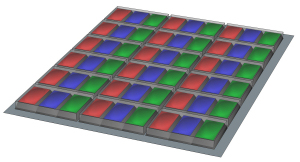 |
| New developments make it possible to have a full RGB sensor on one chip with individual R+G+B subpixels,enabling true 4:4:4 video capturing |
In a three-chip camera the light beam out of the camera lens is refracted with a special trichroic prism block (an assembly comprising two dichroic prisms). This prism block filters the image into the three primary colors, red, green, and blue, directing each color. The three colors are directed to three chips, one for each color. Each of the chips generates a complete video signal for one color, together generating a RGB video signal. |
|
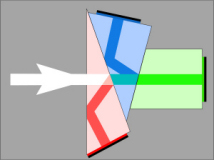 |
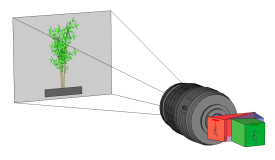 |
<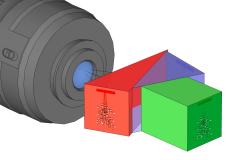 |
| 3-chip prism block for R,G,B | 3-chip camera design | three individual images in red, green, blue |
The 3-chip approach produces high resolutions but cameras are limited to 2/3" chips. Because os the smaller chip size only special lenses can be used. The general image quality can be better than the 1-chip approach but the lens choices with the 3-chip approach are strongly limited. The 1-chip technology allows the use of standard cinema lenses and doesn't introduce a complicated beam splitter prism.
For digital video transmission the RGB signal from the three chips is converted into the YCbCr signal.
Digital sensors for film cameras are built in different sizes. The bets fit is the 'standard' so-called 'full-frame' 35mm sensor that allows to use the exact same lenses for the camera as with the analogue film material. Having a smaller sensor (for example 2/3") by using the same optics means that the useful area of the image circle of the lens is much smaller than with a 35mm film or sensor. A field-of-view crop is happen, changing the optical characteristics. The depth of field becomes wider and less light can be used because of the smaller sensor area. |
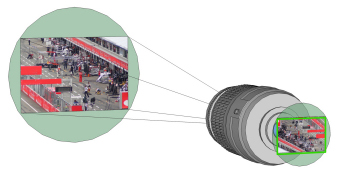 |
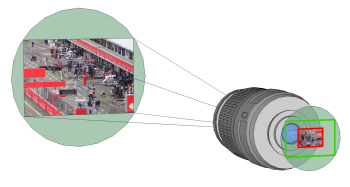 |
| image taken with 'full-frame' 35mm sensor | image taken with 1" sensor and the same lens: large field-of-view crop |
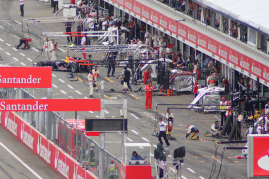 |
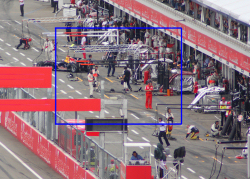 |
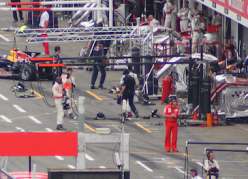 |
| 35mm sensor field | compared to 1" sensor field | field-of-view crop with 1" sensor |
 |
Sensor | Width | Height | Diagonal | Area |
| 35mm | 36mm | 24mm | 43.3mm | 864.0mm² | |
| 1" | 12.8mm | 9.6mm | 16.0mm | 123.0mm² | |
| 2/3" | 8.8mm | 6.6mm | 14.5mm | 58.1mm² | |
| 1/2" | 6.4mm | 4.8mm | 8.0mm | 30.7mm² |